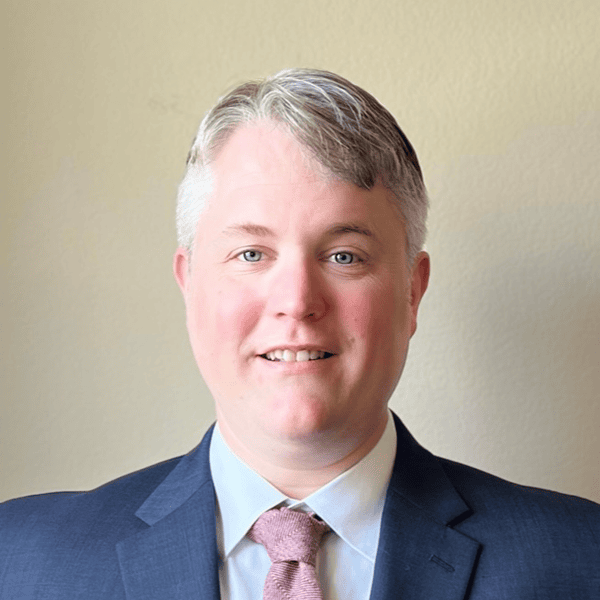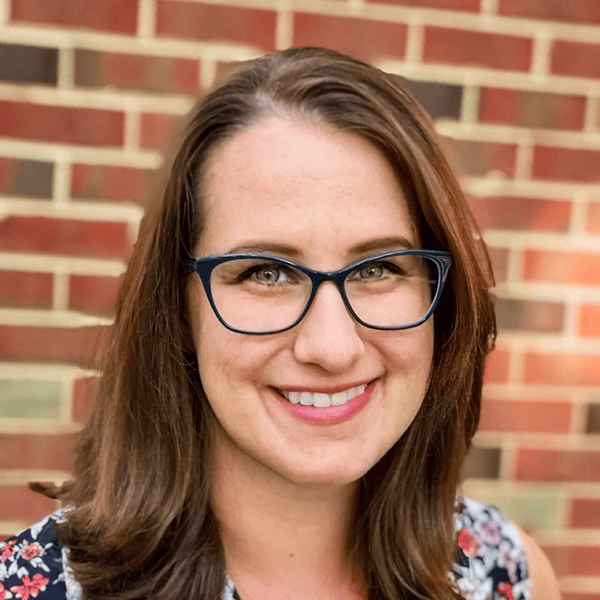San Francisco conjures up images of hills, bridges, the bay, and the Pacific Ocean. But when historians arrived in the city for the AHA annual meeting, they not only enjoyed these aspects of the cityscape but also flocked to New Deal art sites and murals in the Mission District, explored the collections of the Chinese Historical Society of America and GLBT Historical Society Museum, took walking tours of African American history sites, or learned about the freeway revolt as part of a tour of the city’s labor history. These were among the tours offered as part of AHA24, where nearly 3,000 attendees came together to discuss, disagree, learn, and connect.
The annual meeting’s sessions, workshops, and events demonstrated the breadth of scholarship and teaching that historians are engaged in today. At one workshop, participants learned from experienced editors and writers how to pitch, write, and edit op-eds. At a roundtable, the lead editors of OpenStax World History discussed the process of designing and writing this new open educational resource textbook. Journal editors convened around the breakfast table to discuss topics ranging from peer review to the expansion of the types of content published in their journals. Producers of the Southeastern Council of Latin American Studies Historias podcast offered a practicum based on their work creating audio documentaries and accompanying websites. Historians interested in graphic histories held a meetup in the exhibit hall.
Such activities and sessions contributed to making the annual meeting a place for engaging in professional development, exchanging teaching strategies, and learning about colleagues’ research in all its various forms. While we can’t include all the innovative and educational events from the weekend, we offer the following highlights.

Attendees discuss career paths for historians at the Career Fair.
Water Everywhere
In California, water looms large—and not just because of the state’s 840 miles of coastline. California’s history is full of fights around water: from the damming of the Hetch Hetchy Valley to supply water to the Bay Area in the 1930s, to many iterations of the 20th-century water wars, to damage to the Hoopa Valley Tribe’s lands resulting from water diversions, to family farmers’ current struggles to remain in operation while competing with the $5 billion corporate Wonderful Company farm’s control of water rights, competition for this natural resource is central to not only the lives and livelihoods of Californians but also the US food supply.
“There’s not enough water for Indigenous people.”
The breadth of scholarship presented at the AHA annual meeting allowed some participants to think about histories of water and scarcity across the world. At Shrinking Lakes, Disappearing Seas: Water Scarcity in the 20th- and 21st-Century World, presentations on Dar es Salaam, the Aral Sea, the Glen Canyon Dam in the southwestern United States, and California’s Tulare Lake basin looked at how this essential resource has become a commodity. As Erika Bsumek (Univ. of Texas at Austin) asked, “What happens when we recenter views of water not as a commodity? Should we think of it as a commodity at all?” There is also cultural meaning attached to bodies of water, as Sarah Cameron (Univ. of Maryland, College Park) showed in her work on the Aral: “What happens when the sea disappears and you can no longer fish?” The movement of water is itself unique in terms of resources or commodities. “What makes water important to study,” Matthew V. Bender (Coll. of New Jersey) argued, “is that it has a dynamic of movement that other commodities don’t. Surface waters connect people, and it moves from one physical space to another.” But in the American West, Brittani R. Orona (Hupa, Hoopa Valley, and Univ. of California, Santa Cruz) pointed out, “there’s not enough water for Indigenous people.” The Tulare Lake basin, located on Tachi Yokut ancestral lands, was drained in the 1880s for agricultural use. “It’s hard,” Orona said, “to get away from the narrative that water is a commodity.” But the Tachi Yokut have never forgotten the lake and have prophecies about its return.
Historians know that there’s always a longer, broader, more complex history to what we study and what we teach. With the meeting taking place on the Pacific coast, the third annual State of the Field for Busy Teachers session focused on Pacific Rim history. As AHA vice president of teaching Kathleen M. Hilliard said in her introduction, this annual event “aims to bring together experts and educators in a discussion” on the latest historiographical interpretations, primary sources, and practical application in high school and college classes.
Fredy González (Univ. of Illinois at Chicago), a historian of the Chinese diaspora in Latin America, delivered a brief keynote. The field of Pacific history is “following a trend to integrate the Atlantic world,” he argued. In the United States, we often think of the Pacific Rim as primarily East Asia and to a lesser extent Southeast Asia. But those assumptions exclude a lot of territory—the entirety of Latin America’s west coast, the Oceania world of Australia and New Zealand, and 20,000 islands in the Pacific. Many scholars have focused on showing those islands’ significance, emphasizing that the history of these places looks quite different. González argued that it is essential to integrate the Pacific into US history courses because “there is a long history of cultural contact” between the United States and the many regions that make up the Pacific world. His students are often surprised to learn about topics like Chinese people’s experiences in Latin America, and we can show that these migrations are not new. González began his career working on Mexican history, adding the histories of China, Taiwan, and Japan as he became interested in migration from Asia. He recommends looking beyond borders and individual national histories when teaching the Pacific Rim. In his own work and teaching, focusing on the Cantonese Pacific decenters the United States from the narrative, showing “it as a subset of a much larger story.”
Teachers can take multiple approaches to incorporating the Pacific world. For the world history crowd, González said, oceanic history can be an interesting lens. Others might take a thematic approach, emphasizing topics like Indigenous perspectives, ecological exchange, imperialism, trade, migration, and the environment. Another approach is to focus on place, showing how a single location transformed as the Pacific world became more connected. San Francisco can be a great place to do this, he said, when teachers expand beyond the gold rush narrative to explore the wider Pacific, tracing Chinese and Latin American immigration to California. Similar approaches can be taken with cities like Hong Kong and Valparaíso, Chile. Overall, these cities can be treated as a “microsite to think about larger Pacific interactions and flow of capital.” And such stories can be integrated into other courses, including national histories like those of Mexico and Brazil, or those focused on individual populations, such as the history of Asian Americans.
With such a broad territory that includes speakers of hundreds of languages, teachers may find it challenging to find sources and resources their students can read or listen to. González has found it tough to find primary sources and even YouTube videos in English. His students at UIC often struggle to grasp the geography of both Latin America and Asia. But he is grateful to work at an institution with an incredibly diverse student body, where 40 percent of his students are Latinx and he teaches others from Vietnam, Cambodia, and Hawai‘i.
Responding to González’s keynote were two secondary school teachers, Victoria Gray (Los Angeles Unified School District) and Liz Ramos (Alta Loma High School). Still early in her career, Gray has never taught the same set of subjects twice over her five years of teaching. She is currently teaching AP US history and ethnic studies courses, and she finds incorporating the Pacific Rim framing into the latter especially effective. In her school, 98 percent of students are Latino and they are just a few bus stops away from Little Tokyo, so these histories are important to her students. Ramos, who teaches world history and AP government, agrees. She often diverges from the AP curricula in order to ensure that other narratives are included. Local history allows her to incorporate diverse stories about Chinese, Indian, and Filipino immigrants. She always “wants to make sure we are highlighting the strengths of the cultures” she’s teaching about. One way Ramos ensures that she teaches diverse stories is by teaching about her students’ communities. At the start of her world history course, she asks the students where their families are from, then she works to ensure that she includes the history of all students in the class. The students light up when they hear stories they’ve never learned before about their own cultures.
The students light up when they hear stories they’ve never learned before about their own cultures.
With so much content to cover, an audience member asked, how do we incorporate as much coverage as possible in these courses? “Rather than content,” González answered, “I try to stress getting students to think more open-mindedly.” While many associate undocumented immigration with Mexican populations, he teaches students about how some of the first undocumented migrants were Chinese—they came through Mexico during Chinese exclusion, when Mexicans were allowed to migrate without the same limitations. Complicating students’ assumptions and what they think they know about history can make a difference.
What kinds of resources do these educators use? González recommended A Primer for Teaching Pacific Histories: Ten Design Principles by Matt K. Matsuda. He also mentioned the two-volume Cambridge History of the Pacific Ocean. While he doesn’t assign that text, its breadth can provide a starting point for lectures. Gray recommended ArcGIS StoryMaps as useful in helping students connect with these histories. She made one map highlighting the experiences of a Boyle Heights local who was incarcerated during Japanese internment, and she hopes to have students use StoryMaps in the future for an assignment about community ethnography. Because many of her students are English language learners, visual resources like these maps are incredibly helpful.
Overall, these three educators emphasized that even with such a broad topic, you can include historiography and complex stories. González reminded the audience that they must “be sure that history doesn’t end” for Indigenous people when Europeans arrive, and that these populations continued to have agency—for example, European ships were often crewed by Pacific Islanders. By leaning into that complexity, students will come away with a new understanding of the Pacific world.

Attendees got to play with the puzzles recently completed by artist Ebony Iman Dallas of the Afroaquatics project. Laura Ansley, with permission of the artist
Our classrooms aren’t the only place historians can address the complexities of the past. The Afroaquatics project, a collaboration among academics, community organizers, and an artist, breaks down misconceptions about the relationship of African diasporic peoples with water, swimming, and other water sports. Arising from a community listening session in Oakland, this project addresses “deep-seated historical fears and historical myths that have been perpetuated about Black bodies in the water,” Amanda E. Herbert (Durham Univ.) said in introducing the Open Water: Afroaquatics and History session.
“The more we can heal their relationships to water, we can heal their relationships to themselves.”
Herbert and fellow scholars Amber N. Wiley (Univ. of Pennsylvania) and Kevin Dawson (Univ. of California, Merced) teamed up with community organizers and youth advocates Dwayne Anthony Aikens Jr. and Frank Clayton and artist Ebony Iman Dallas to address this problem. Aikens’s nonprofit We Lead Ours offers summer camps with outdoor activities, while Clayton has been involved with the Oakland Strokes Rowing Club. Both saw firsthand the fear that Black kids often brought to water sports. As Aikens said, harking back to the transatlantic slave trade, “There is deep trauma there from the stories we hear growing up as Black folks about what happened on the east coast of the United States.” These fears are often intergenerational, with parents as worried as their children about swimming or rowing. Yet as Clayton stated, “We are 60-plus percent water.” He continued, “The more we can heal their relationships to water, we can heal their relationships to themselves.”
With this guidance from Oakland community members, and historical research from Dawson, Herbert, and Wiley, Dallas created a series of three wooden puzzles that address the history of African-descended people and water. The puzzles cover three time periods: 1000–1500, 1500–1900, and 1900–Future. The final puzzle includes a mirror, so children can see themselves in the story. The puzzles are in wooden cases; behind the puzzles themselves, there is text based on archival research carved into the case that gives context for the myths, people, and places depicted. The team sees these puzzles as “a ready-to-go pedagogical tool kit.” Now that the puzzles are completed, the team hopes to use them in the Oakland community to engage children in the history of water. Meanwhile, Dallas is beginning work on a second set of puzzles, which look at a more UK-focused history, highlighting Black Britons in the third puzzle. The team is also looking for other ways to engage the community, such as including the puzzles in summer programs and other advocacy opportunities.
The audience was delighted by the puzzles, spending the final half hour of the session examining and playing with them. It became clear to attendees that an immense amount of work went into this project, with each team member bringing a unique perspective and set of skills and each learning from one another. For art historian Wiley, this “gave me the opportunity to think about how—either through visual storytelling or three-dimensional embodied space—we have relationships with water.” She now sees a great richness in this subject that she previously overlooked in her teaching—“you could teach a whole class on Afroaquatics through art history!” For historian Herbert, working on an art-based project has expanded her imagination. Used to working with “bits and scraps and fragments,” she found it rewarding to “turn toward works of art to see how they fit the patterns. And, as Dawson emphasized, there’s no one meaning in art. “Sometimes the danger is that as a historian we are sometimes looking for one truth,” he said, “but that’s not always the way.”
—LA
Honest History
History education is a major front in the current culture wars across the United States. From South Dakota to Florida, politicians and legislatures have sought to interfere with history instruction in secondary and undergraduate classrooms. Several sessions at the annual meeting confronted the challenge of teaching history in such a highly charged political environment.
Culture wars around history education often hinge on exaggerated rhetoric that may have little to do with what happens in most classrooms. American Lesson Plan: A Progress Report summarized some of the preliminary findings of the AHA’s Mapping the Landscape of Secondary US History Education project, offering a nuanced empirical analysis of what schoolchildren across the country are being taught about US history. Drawing on more than two hundred educator interviews, a survey of thousands of US history teachers, a database of state legislation, and an array of school district–level curricula, the research team—Whitney E. Barringer, Nicholas Kryczka, and Scot McFarlane—concluded that, while there is certainly room for improvement, most teachers offer some variation on a broadly consistent accounting of US history that accords with disciplinary norms. Unprecedented in its scale and comprehensiveness, this research provides a strong empirical foundation to counter competing partisan caricatures of US history classrooms. It will also undoubtedly inspire and inform conversations about how research and scholarship can continue to inform the work of K–12 teachers.

Jonathan Zimmerman (Univ. of Pennsylvania) speaks during the Thursday plenary on state-level politicization of history education.
At the Thursday plenary, The Politicization of History Education at the State Level: Legislation and Standards, chair Amna Khalid (Carleton Coll.) began the discussion by asking the panelists for their views on the import and impact of Florida’s “naked attack” on higher education via the “Stop WOKE Act” and the state’s recent revisions to its African American history curriculum. Julia Brookins (AHA senior program analyst, teaching and learning) offered a framework to understand the discussion. State educational standards, she said, are intended to be revised regularly to bring instruction up to date and in line with the academic consensus. But many things that are uncontroversial within the academy are highly controversial among the general public. She observed that the politicized environment has led to these established statewide processes breaking down in spectacular, public ways.
Lawrence Paska (National Council for the Social Studies) explained that when the first national standards were developed 30 years ago, they were intended to serve as guidelines to help educators and guide classroom discussions. Their first reworking in 2004–07 was a researcher- and educator-led process, but also involved the public and a deep engagement with social studies boards and trusted professional organizations across the country. In this process, the problem was always inclusion: How does one include all the important histories that need to be told? Today, he said, the conversation instead focuses on ensuring certain histories are excluded.
Everyone can have a role in mobilizing public support for our schools, colleges, and universities, even under otherwise hostile circumstances.
Stephen Jackson (Univ. of Kansas) discussed his own involvement in—or rather, exclusion from—the development of state standards in South Dakota while he was a faculty member at the University of Sioux Falls, a subject on which he has written for Perspectives. Jackson noted the major influence of Hillsdale College on the curriculum’s final draft, evident in phrases like “content-rich pedagogy” (i.e., an insistence on memorization over inquiry) and an exceptionalist interpretation of American history. Further, he explained, the standards do not seem to have been developed with any regard to the grade level of the students to whom they are supposed to be taught.
What damage could such problematic state standards cause? N. D. B. Connolly (Johns Hopkins Univ.) noted that, in their attempt to refute the New York Times 1619 Project, the new Florida standards promote American exceptionalism at the expense of Florida’s own history. How does he know the project is the main target of the standards? The titular date, which is all over the new standards, was absent entirely from those approved in 2014. But, he warned, the curricular revisions have a larger target too. Paired with attacks on public universities, he described the efforts of Floridian politicians as an assault on the idea that education should be provided to those who cannot pay to access it. At its core, this is an attack on one of the last and most potent bastions of the ideas inherent in post–Civil War Reconstruction: that public education is a “base protection for a democratic population.” Historians must therefore come together and defend Reconstruction as a principle.
When asked if the current attacks on public education are unique, Jonathan Zimmerman (Univ. of Pennsylvania) reflected on the late 20th-century trajectories of the “religion wars” over the teaching of creationism, the place of the Bible in the classroom, and school prayer, as well as the “history wars” that sought to challenge the limited viewpoint from which earlier histories were written. Both ideological controversies flared in the waning years of the last millennium but had been relatively quiet since. The former, Zimmerman said, were unresolvable because they involved incommensurate claims; the latter found the wrong solution by simply including more histories to the same structure. And while the religion wars have cooled over the past two decades, the history wars have exploded. This is in part the product of first attempts to move past simple inclusion and to reimagine the historical narrative at a fundamental level; Zimmerman saw recent legislation in states with conservative majorities as a means of preventing this change. He advised participants to butt in; it’s still a democracy, as long as we can keep it.
On this final point, Connolly concurred but with a twist. It is impossible, he argued, to expect reasoned debate to counter concerted political organization. The current attacks on honest history in Florida and elsewhere, he argued, are the result of American liberalism’s failure to build “progressive political capacity.”
Several events at the meeting offered ways for historians to become more engaged in defending the discipline. Advocating for History: A Workshop on Steps and Strategies to Support the Discipline brought together representatives from state and national organizations to facilitate a discussion about building public and community support for historians’ work. The workshop centered around the coalition that formed in support of the professional integrity of Virginia’s state standards for K–12 history education, using this network of educators as a case study for the ways teachers and historians can promote the needs of students when other factors intrude on education policy. The panelists made the case that everyone can have a role in mobilizing public support for our schools, colleges, and universities, even under otherwise hostile circumstances. In Virginia, to cite just one example, local labor union members turned out at public hearings over proposed new state standards, but only after teachers had pointed out that almost all references to labor and working conditions had been excised from the draft. The final version of the standards adopted in 2023 were much better than they would have been had Virginia educators not stood up to defend a full and honest accounting of history in public schools.
—BG and LRG
In the Classroom
Conversations about history in the classroom began even before the official start of the meeting with a Thursday-morning workshop on the future of history in liberal arts colleges. Designed to foster conversations among liberal arts college faculty across the United States, this year’s workshop was organized by Jordana Dym (Skidmore Coll.) and Jakub J. Kabala (Davidson Coll.). Approximately 30 participants discussed issues acutely felt at, though hardly confined to, liberal arts colleges, including the use of potentially traumatic texts in the classroom, instruction on the current war in Gaza, and fears of being reported to the administration by one’s students. Alina Wong (Macalester Coll.) said there is no miracle cure to avoid classroom controversy. Both students and teachers come to the classroom with ideas, identities, and values that they believe are correct. If the history they encounter in the classroom challenges those preconceived notions, she noted, it leads to dissonance and thus discomfort, both of which are part of learning any subject. Resisting ideas that cause dissonance is very human, making it important to teach both students and teachers how to have these conversations while also building in space to make mistakes.
In this regard, college-age students pose a unique challenge, as Gen Z is distinct from their earlier peers, Wong said. Such students often bear the weight of exceptionally high expectations, particularly those who come from low-income families. They are more politically engaged than earlier generations, and social media, usually accessed via their phones, has a marked effect. Students are more inclined to think in binaries and to view demands on their attention as immediate, urgent, and transactional. But they are also more pragmatic and have a marked preference for nonhierarchical leadership arrangements. Above all, they have an overwhelming concern with how they are perceived by themselves and others; in contrast to millennials, Gen Z students often cannot stand seeing their own image during a Zoom meeting. These differences, Wong noted, must be taken into account in the development of new educational strategies. As the workshop showed, teaching is a process of continuous learning.
There are some parts of history teaching that simply cannot be up for debate.
This conversation continued with a session on preparing tomorrow’s K–12 teachers, chaired by Nicholas Kryczka (AHA) and featuring Brad Fogo (San Francisco State Univ.), Brittany Jones (Univ. at Buffalo, SUNY), Craig Perrier (Fairfax County Public Schools), Brenda J. Santos (Univ. of Rhode Island), and Darion Wallace (Stanford Univ.). Here, the focus moved from the classroom to the broader educational ecosystem—teacher preparation programs, education research, and school district administration—where social studies teachers work and learn.
Preparing future social studies instructors to teach and engage in ongoing professional development is a process complicated, panelists said, by both a decrease in professional development funding and the fact that many state educational standards consider social studies a vehicle for civics education. The current intensification of curricular oversight by state and local officials further compounds these issues.
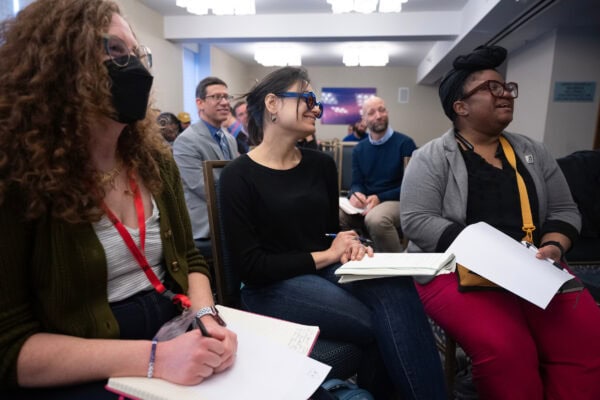
Faculty from small liberal arts colleges across the country gathered to discuss the unique opportunities and challenges of their institutions.
Social studies is not often the target of so-called “high-quality curriculum materials” laws, which mandate the adoption of certain external materials to guide classroom instruction. Nevertheless, such legislation can constrain teachers, who need “continued, sustained support” in the form of strong, well-vetted instructional materials that come with the imprimatur of a well-known brand. In the current political environment, the panelists argued, people will object to new material, and it must therefore have an unimpeachable pedigree.
Yet, although quality materials could ease the process, the panelists insisted, there are some parts of history teaching that simply cannot be up for debate. Teaching honest history will therefore remain, as it has always been, a discomforting, “political” act. Teachers, they said, need both strong institutional backing and training in how to prepare a classroom to do the necessary controversial work. Here, the panelists advocated for the development of a “relationship-based classroom” that focuses on history as a means of understanding one another. This in turn requires teachers to make sure each of their students knows the importance of studying history. As one panelist put it, we have spent far too much effort arguing over what history to teach and not nearly enough discussing why we must teach history.
—LRG
A Historiography of the American Right
The Saturday plenary, Rethinking the Far Right in American History: Questioning Old Paradigms, Asking New Questions, and Engaging Broad Publics assembled, aptly, on January 6. The session marked the 30th anniversary of an American Historical Review forum that included Alan Brinkley’s article “The Problem of American Conservatism,” in which he argued that Reaganism was not the end of American conservatism and called for the need to know more about the Right, a need still felt three decades later. Organized and chaired by Seth Cotlar (Willamette Univ.), the panel, including Kim Phillips-Fein (Columbia Univ.), Nicole Hemmer (Vanderbilt Univ.), Anthea D. Butler (Univ. of Pennsylvania), Matthew Sitman (Know Your Enemy podcast), and Rachel Maddow (MSNBC), was more than up to the task.
Phillips-Fein asked, despite conservatism’s continued domination of American politics, why historians know so little about it. She offered an overview of evolutions in our understanding of the movement since Brinkley, including its undefinably wide breadth of ideas; how conservatism is a project of political elites; and how the movement has evolved since the 1990s in opposition to many of the fundamental tenets of Reaganism. Hemmer next offered her thoughts on the term “Far Right” itself. There is something worthwhile, she said, about marking a portion of the Right off from the rest of the movement, but she cautioned that the term does other, more subtle work by separating an extreme from the mainstream and defining the “center Right” as normative and ideal. The term, she argued, creates an artificial distinction between extremist groups and the mainstream political institutions that are necessary for them to flourish. Further, since it offers a relative (rather than absolute) relationship between center and fringe, the term creates a moving target that is hard to historicize. Is it “far” because it’s violent, undemocratic, or for some other reason, and what is lost when these various characteristics are collapsed? she asked.
Maddow argued that it is necessary for the entire discipline to be willing and able to speak to a public audience.
Butler called attention to the parallelism and symbiosis between the religious Right and the Far Right. Donald Trump’s presidency was, she said, the end result of over 50 years of efforts aimed at imposing a belief structure on the country, hidden behind rhetoric of protecting one’s individual moral choices. Butler took issue with religious scholars’ hyperfocus on American evangelicals, a preoccupation that has obscured other fundamentalist movements that are “hidden in plain sight.”
Maddow’s inclusion on the panel, she said, stemmed from her podcast, Ultra, on fascism in the United States in the decade prior to World War II and the book that resulted from the project. This story, she argued, offered several important lessons: that a substantial portion of the American political establishment was sympathetic to the Nazi cause, that the United States did not truly form a united front against fascism, and that politicians who were under investigation managed to successfully wield their political power to get themselves off the hook. And yet although this is a tale well known to specialists, she learned it is frustratingly unknown to the general public. She argued that it is necessary for the entire discipline to be willing and able to speak to a public audience. To this end, she promised to “try to get all the MSNBC moms and grandpas to read your work.”
Finally, Sitman offered a more personal perspective from his own experiences as an ex-conservative. He took up a defense of the term “Far Right” against Hemmer’s critique, arguing that the amorphous nature of the term is precisely what made it useful, offering both a positional and a relational description of right-wing groups. It is important to understand and emphasize the relationships between extremist groups and conservative institutional apparatuses like think tanks when talking about right-wing politics. And finally, the umbrella term enables a discussion of the Far Right as a global intellectual phenomenon, with extremist groups in different parts of the world able to learn from each other without any direct hierarchical ties.
During the Q&A, the panelists stressed the importance of understanding the Far Right not as a pathology but as the product of “a very real place” and as the “wages of neoliberalism.” Further, they noted the difference between the Right’s embrace of grassroots movements when compared to the Democratic Party’s attempt to isolate those on the Left—why, they asked, is there no progressive equivalent of the Federalist Society? But they also cautioned that the current state of the Republican Party was the result of a coup by those movements, not an amicable ceding of authority.
—LRG
Laptop Stickers Galore
Laptops are more common than elbow patches at AHA24. Here are a few personalized laptops captured on camera.

Laptop with stickers

Laptop with stickers

Laptop with stickers
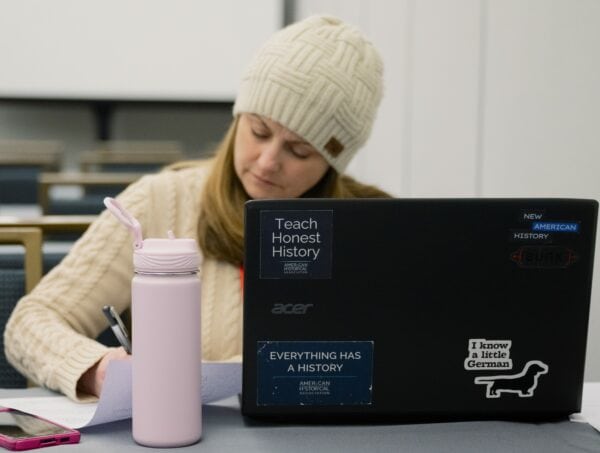
Laptop with stickers

Laptop with stickers
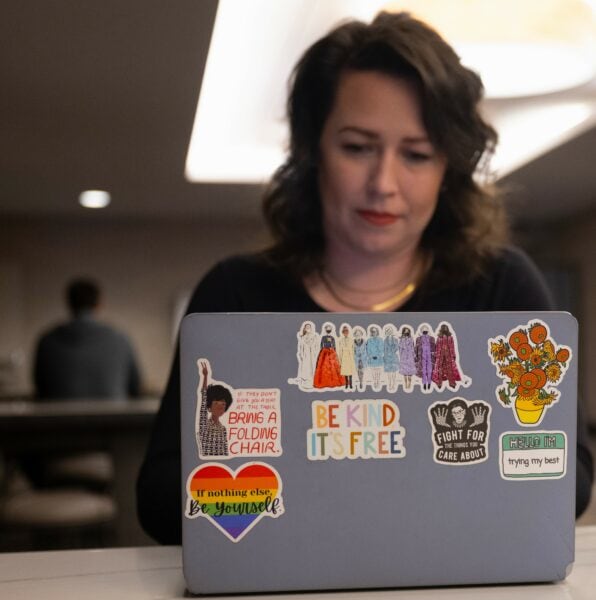
Laptop with stickers

Laptop with stickers
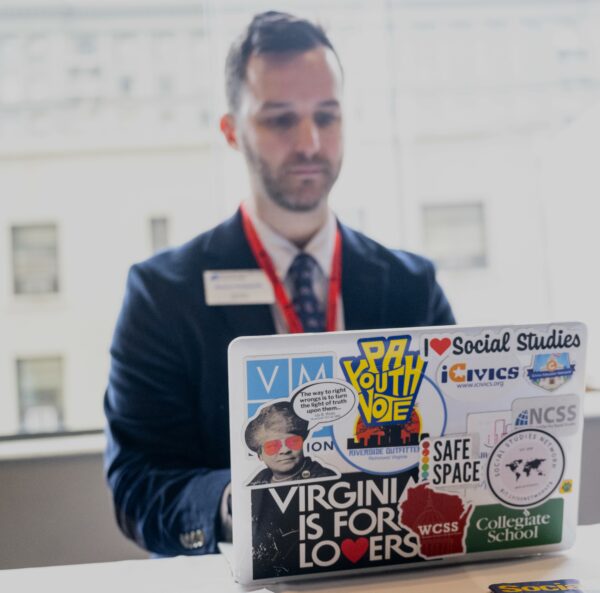
Laptop with stickers

Laptop with stickers
An Evolving Event
As executive director James Grossman noted in Perspectives in January, the Association is “committed to continuing the process of change in the structure and culture of the annual meeting.” This year’s meeting included sessions and events in a range of formats.
For the LGBTQ+ History Research Lightning Session, which drew inspiration from the digital humanities unconference “dork shorts,” rather than formal presentations, members of the audience were invited to the podium to share their research in timed three-minute presentations. Chairs Julio Capó Jr. (Florida International Univ.), Claire Bond Potter (New School), Dan Royles (Florida International Univ.), and Susan Stryker (Univ. of Southern California) cultivated a relaxed and supportive environment, urging participants that research could be in any stage of development and that all were welcome to share.
Despite the nerves of presenting unfinished research, undergraduates and advanced scholars alike encouraged each other’s contributions to the field as the session format became clearer and more comfortable. Audience members took turns presenting on various queer topics, including trans history on university campuses, LGBTQ K–12 education, the HIV/AIDS epidemic, the history of gender, and more. Multiple archivists came to the group asking how they could help reconcile the gaps in their collections. After the lightning rounds, session chairs created discussion groups around broader queer history topics based on the research presented “to help scholars make connections with each other and share information” for the second half of the session. Attendees picked each other’s brains on where to source information for their research, exchanged contact information, and talked through their projects.
Attendees participated in numerous professionalization and teaching workshops during the meeting. These ranged from the Op-Ed Workshop to a hands-on session led by Sarah Weicksel (AHA) on teaching with material culture to the annual K–16 workshop hosted by the Library of Congress. The Teaching Writing Workshop focused on teaching in the age of AI and attracted a standing-room-only crowd to discuss ideas and strategies for navigating the rapidly changing landscape of generative artificial intelligence. There is no single answer, but panelists Bob Bain (Univ. of Michigan), Laura Brade (Albion Coll.), and Laura Westhoff (Univ. of Missouri, St. Louis) highlighted various mechanisms for helping students understand the strengths and limitations of AI tools. Students are less likely to turn to chatbots when completing highly scaffolded assignments, informal writing can help develop critical thinking habits, and critiquing AI-generated texts offers lessons that can make us better writers. Whether or not you embrace these tools, open and honest discussion about what they can and cannot do well will bring considerable value to both instructors and students.
This year’s poster sessions were found in the exhibit hall and featured dozens of scholars’ research, including over 50 graduate and 20 undergraduate presenters. Poster topics ranged from living near active volcanoes and birth control in Pittsburgh’s African American communities to Massachusetts cemeteries and Texan communists. Whatever your interests, the poster sessions are always worth a visit—if you missed it in San Francisco, be sure to check them out next year.

Those who visited the poster sessions in the exhibit hall found a lot to talk about.
The orbital center of any academic conference is the exhibit hall. What’s not to love about piles of books and conversation with a stranger over the recently released volume you both happen to be ogling? It’s hard not to stop by, and harder to leave in time to make it to the next session. This year’s meeting’s exhibitors featured everything from books to educational resources to sabbatical rental properties. And for those who took time to stop by the AHA booth, whether it was to check for directions, enter the tote bag raffle, or chat with the Perspectives editors, it was lovely to meet you!
—BG, LRG, and LM
On to New York City

On Saturday evening, Thavolia Glymph (left, pictured with Lauren Gutterman at the LGBTQ+ Historians’ Reception) became the 140th president of the American Historical Association.
We hope you’ll join us in the process of experimenting at the annual meeting by proposing your own sessions, workshops, and other formats as we look ahead to gathering next year. The 138th annual meeting will be held January 3–6, 2025, in New York City. Proposals for sessions that advance the study, teaching, and public presentation of history are due February 15, 2024. We hope that you will submit a proposal, consider creative formats, and join us next year.
Photographs by Marc Monaghan (unless otherwise noted)
This work is licensed under a Creative Commons Attribution-NonCommercial-NoDerivatives 4.0 International License. Attribution must provide author name, article title, Perspectives on History, date of publication, and a link to this page. This license applies only to the article, not to text or images used here by permission.

